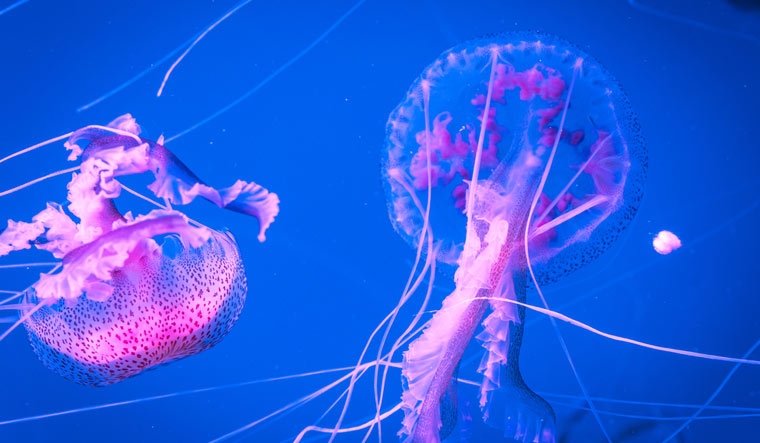Jellyfish, devoid of a central brain, have astounded scientists by demonstrating the ability to learn from past experiences, akin to the learning capabilities observed in humans, mice, and flies, according to a groundbreaking report published on September 22 in the journal Current Biology. Researchers successfully trained Caribbean box jellyfish, specifically Tripedalia cystophora, to identify and evade obstacles, thus challenging the conventional belief that sophisticated learning necessitates a centralized brain. This discovery offers invaluable insights into the evolutionary origins of learning and memory.
Despite their diminutive size, these seemingly uncomplicated jellyfish possess a complex visual system comprising 24 eyes intricately embedded within their bell-shaped bodies. These remarkable creatures inhabit mangrove swamps and rely on their visual prowess to navigate through murky waters, deftly avoiding underwater tree roots while hunting for prey. The study unveiled the jellyfish's capacity to acquire the skill of obstacle avoidance through associative learning, a cognitive process that involves forming mental connections between sensory stimuli and corresponding behaviors.
Jan Bielecki, the first author of the study from Kiel University, Germany, remarked, "Learning is the pinnacle performance for nervous systems." He emphasized the importance of leveraging the jellyfish's innate behaviors to effectively impart new skills, aligning with the animal's natural instincts.
To facilitate this learning process, researchers configured a circular tank adorned with alternating gray and white stripes to replicate the jellyfish's natural habitat. In this simulation, gray stripes represented distant mangrove roots. Over the course of 7.5 minutes, the researchers observed the jellyfish's behavior. Initially, the jellyfish closely approached these seemingly remote gray stripes, resulting in frequent collisions. However, as the experiment unfolded, the jellyfish displayed remarkable progress. By the end of the observation period, it had increased its average distance from the tank's wall by approximately 50%, quadrupled the number of successful maneuvers to avoid collisions, and halved its contact with the wall. These findings provide compelling evidence that jellyfish can indeed learn from their experiences, particularly through visual and mechanical stimuli.
Anders Garm, the senior author of the study from the University of Copenhagen, Denmark, emphasized the significance of studying relatively simple nervous systems in jellyfish as a means of comprehending intricate behavioral mechanisms. He stated, "Looking at these relatively simple nervous systems in jellyfish, we have a much higher chance of understanding all the details and how it comes together to perform behaviors."
To delve deeper into the jellyfish's associative learning process, researchers turned their attention to the rhopalia, the animal's visual sensory centers. Each rhopalium houses six eyes and generates pacemaker signals that control the jellyfish's pulsating motion, which intensifies when the creature maneuvers around obstacles.
In an intriguing experiment, the researchers exposed the stationary rhopalium to moving gray bars, simulating the jellyfish's approach to objects. Initially, the rhopalium remained unresponsive to light gray bars, interpreting them as distant. However, after the researchers subjected the rhopalium to mild electric stimulation coinciding with the approach of the bars, it began generating signals for dodging obstacles in response to the light gray bars. This electric stimulation effectively mimicked the mechanical stimuli of a collision. The results not only underscored the necessity of combining visual and mechanical stimuli for associative learning in jellyfish but also established the rhopalium as a vital learning center.
 The power of learning from failure: A sign of high intelligence
The power of learning from failure: A sign of high intelligence
The research team's future endeavors include delving deeper into the cellular interactions within jellyfish nervous systems to unravel the intricacies of memory formation. Additionally, they aim to gain a comprehensive understanding of the mechanical sensor in the jellyfish bell to provide a holistic view of the creature's remarkable associative learning abilities.
"It's surprising how fast these animals learn; it's about the same pace as advanced animals are doing. Even the simplest nervous system seems to be able to do advanced learning, and this might turn out to be an extremely fundamental cellular mechanism invented at the dawn of the evolution of the nervous system," Garm said with amazement.


